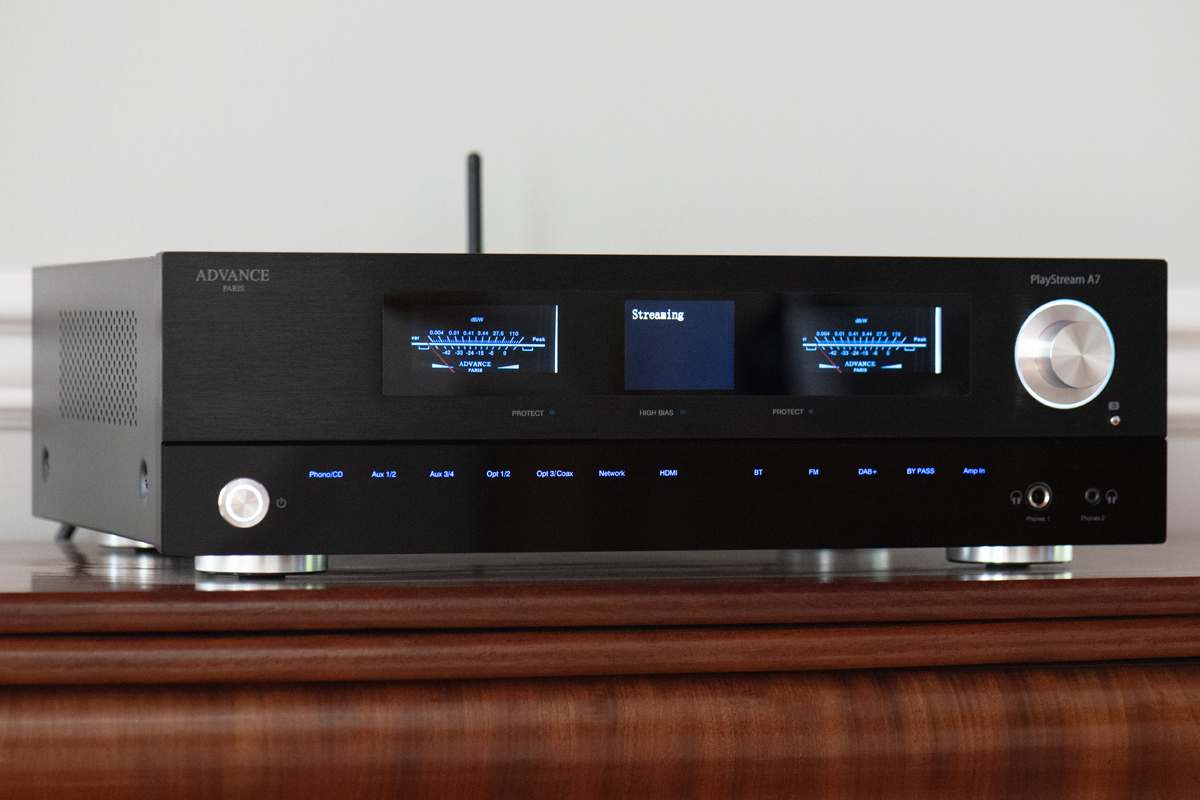As much as I love the quality and convenience of modern connected audio—not to mention the incredible value provided by music services such as Qobuz—I must admit I understand why some audiophiles prefer to stick with their traditional media and more boutique-y gear.
At least I think I do. Most modern, connected hi-fi equipment selling for anything resembling a reasonable price sort of seems designed by committee, somewhat sterile, or at the very least rather mass-produced.
And when that isn’t the case—for example, I’d argue that my reference NAD C 3050 integrated amplifier has some quirk and charm of its own—it generally comes down to superficial aesthetics. The C 3050 is a hyper-modern, class-D streaming amp with a switching power supply and a core that’s more computer than anything else, with just enough faux-wood vinyl wrapping and VU-meter eye-candy to evoke classic hi-fi gear and keep my retro sensibilities satisfied.
But what if you’re looking for something grounded in old-school audiophile principles, something truly boutique-y, something that doesn’t seem focus-tested and stamped out by a cookie cutter, but that nonetheless has all the convenience of the sort of modern gear typically written about here on Simplifi? It seems to me that this is exactly the sort of niche the Advance Paris PlayStream A7 integrated amplifier (US$2499, CA$2350, £1750, €1499) is designed to fill.
It’s a gorgeous thing, but it has the look of something engineered by a passionate audiophile, not an engineering department. Its centrally positioned text display—populated by an oddly anachronistic but lovely serif font—is flanked by a pair of glowing VU meters that seem designed to pander to me. The off-center volume knob has less heft than you might expect, but feels great in the hand, and I could just as easily see this thing appealing to pure analog music junkies with no interest in its streaming capabilities, as well as connected hi-fi enthusiasts who wouldn’t listen to vinyl under threat of bodily harm. That’s a neat trick in and of itself.
Inside and out
The PlayStream A7 is a robust integrated amp with class-AB topology and specified output of 115Wpc into 8 ohms. Although no specifications are given for lower-impedance loads, the massive toroidal transformer and my subjective testing lead me to strongly suspect that it should at least come close to doubling its output into 4 ohms and is probably quite stable below that.
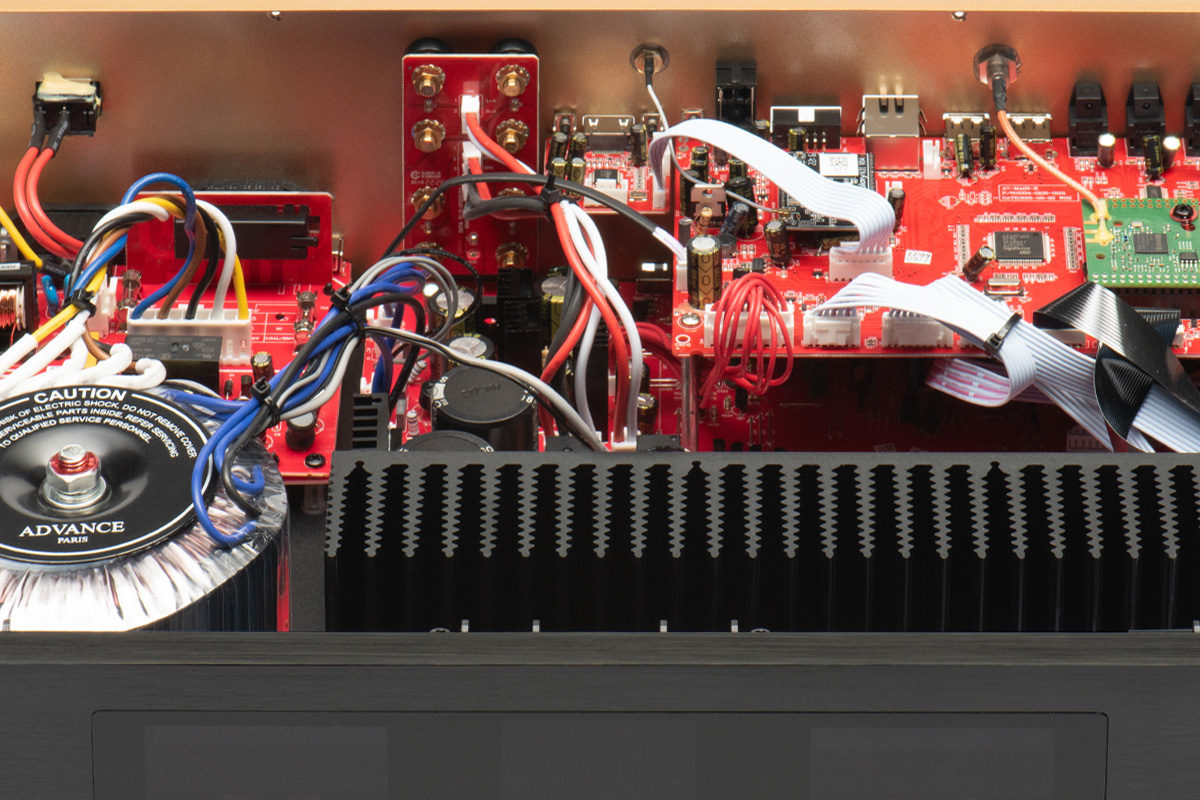
All told, it features one coaxial and three optical digital audio inputs; a phono stage with support for MM and MC cartridges (high and low gain for the latter, selectable via a DIP switch); five line-level stereo RCA inputs; a record out; a stereo RCA pre out; an amp in; dual subwoofer outputs; an HDMI ARC port; hard-wired and wireless network connectivity; a DAB/FM antenna connection; two 12V trigger outs (3.5mm); and a connection for Advance Paris’s X-FTB01 and X-FTB02 Bluetooth receivers, the latter of which supports aptX HD.
The X-FTB01 that shipped with my review unit only officially supports the standard aptX codec according to the Advance Paris website, but much to my surprise, it also supports AAC for Bluetooth, and indicates as such via the front-panel screen. There is also a USB-A port on the back panel that supports playback of MP3, WAV, FLAC, ALAC, and AAC files from a thumb drive.
The PlayStream A7 features a High Bias switch on the back that allows you to bump the standing bias current from an unspecified default up to the point where the amp effectively operates as class A for the first watt. That’s still not a high enough standing bias current to qualify as “high bias,” but that’s just my opinion, and you’re under no obligation to care what I think about it.
The front panel features touch-sensitive source-select buttons, although there’s a bit of overlap. The same button, for example, is used to choose the CD and Phono inputs, despite their being separate physical connections. Curiously, that double-dipping doesn’t apply to the remote control, which gives you no direct way of accessing the Phono input, unless you tape the Mode button and use the d-pad to scroll through the list of inputs on the amp’s display. And frankly, it’s difficult to read that list from more than about four feet away.
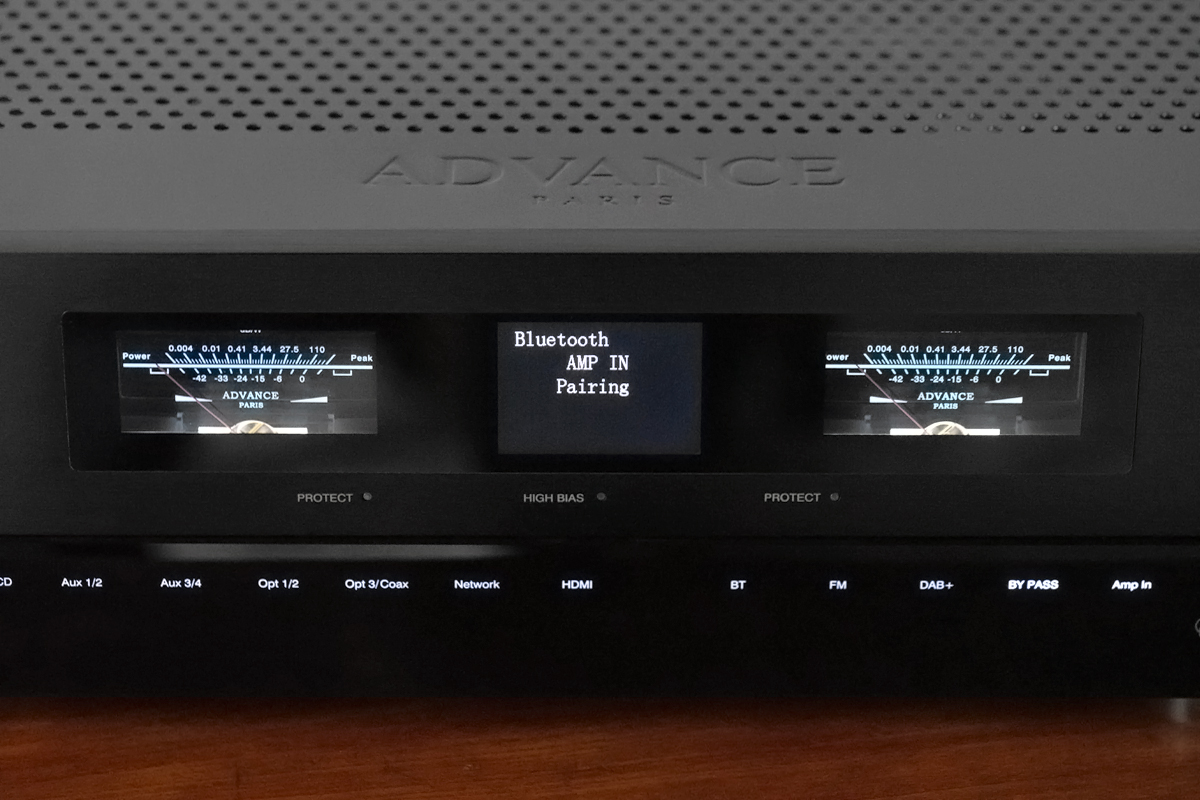
That sort of thing would normally aggravate me, but the PlayStream A7 frankly charmed me so much that I forgot about it after a day or so. What’s more, when I’m spinning vinyl, I’m walking over to my gear rack anyway, so pressing the Phono/CD button didn’t bother me a bit. The rest of the inputs are similarly forced to tolerate roommates on the front panel, with the rest of the dual-function buttons breaking down as follows: Aux 1/2, Aux 3/4, Opt 1/2, Opt 3/Coax, Network, HDMI, BT, FM, DAB+, BY PASS, and Amp In. Why FM and DAB+ get their own separate buttons but CD and Phono get crammed into one is beyond me, but hey, there’s a lot I don’t understand about the way the world works.
One last front-panel detail worth pointing out before we get to the innards and network connectivity is that there are separate 6.35mm (¼″) and 3.5mm headphone outputs, side by side.
Setup and software
If you choose to treat the PlayStream A7 like the network integrated amplifier that it is—and again, it’s totally valid if you don’t, given its legitimate old-school audiophile bona fides—you’ll need to download the Advance PlayStream app for iOS or Android. Setup was frankly so straightforward and painless that I’ve mostly forgotten about it. I connected the PlayStream A7 via ethernet, fired up the app, and the app effectively said, “Ooh, hey, I know what to do here! Just check a few boilerplate boxes to give me the standard permissions, and let’s rock!”
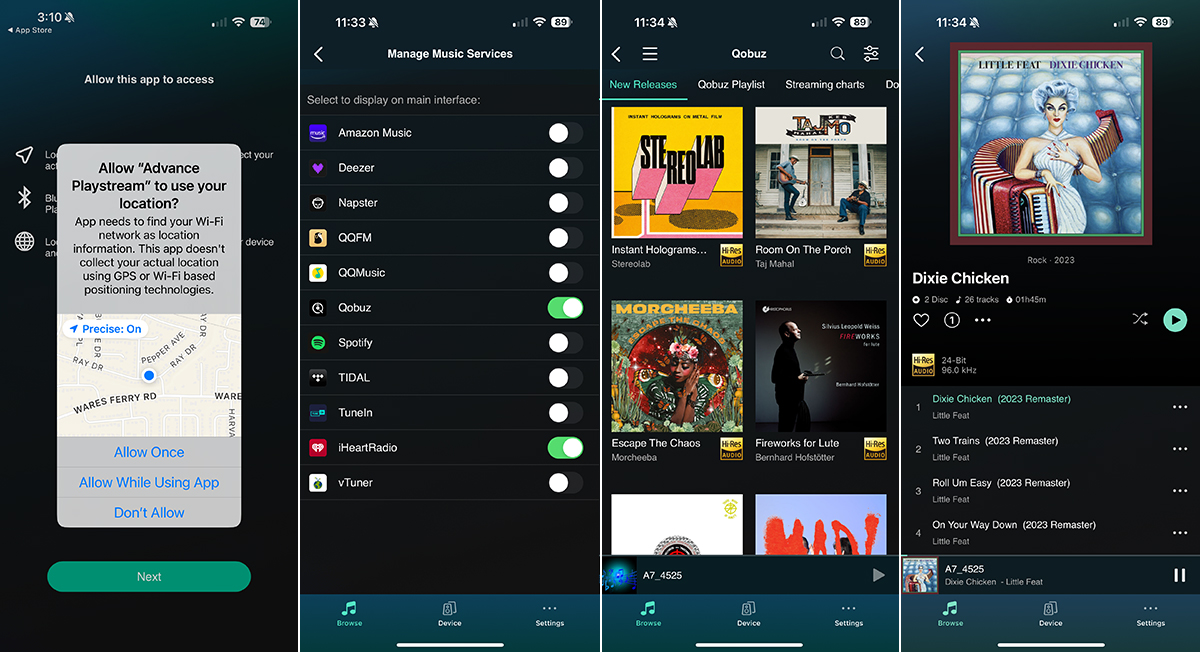
I’m paraphrasing, of course. The long and short of it is, once you get the amp and the app connected, it’s a simple matter to add your login info for your streaming music service(s) of choice—Amazon Music, Deezer, Napster, Qobuz, Spotify, Tidal, TuneIn, iHeartRadio, and/or vTuner—and you’re in business. It’ll also seamlessly pull music from the library of music stored on your phone, which is something we iPhone folks don’t take for granted.
I also very much dug the way Qobuz was integrated into the Advance PlayStream app, which isn’t always a given. Searching for tunes was surprisingly seamless for an app designed by an audiophile brand instead of a mass-market music brand. The only quirks that really bugged me with regard to day-to-day navigation of the app were the fact that the PlayStream A7 doesn’t feature any network wake-up functionality I could locate, and if I forgot and started the app before turning on the amp, it would occasionally just forget that I had ever set up the amp within the app to begin with, which meant I also had to put my Qobuz credentials in again. The lack of network wake-up also means you can’t fire the amp up by selecting it as an AirPlay endpoint, since it doesn’t show up as an AirPlay endpoint unless the hardware is already awake.
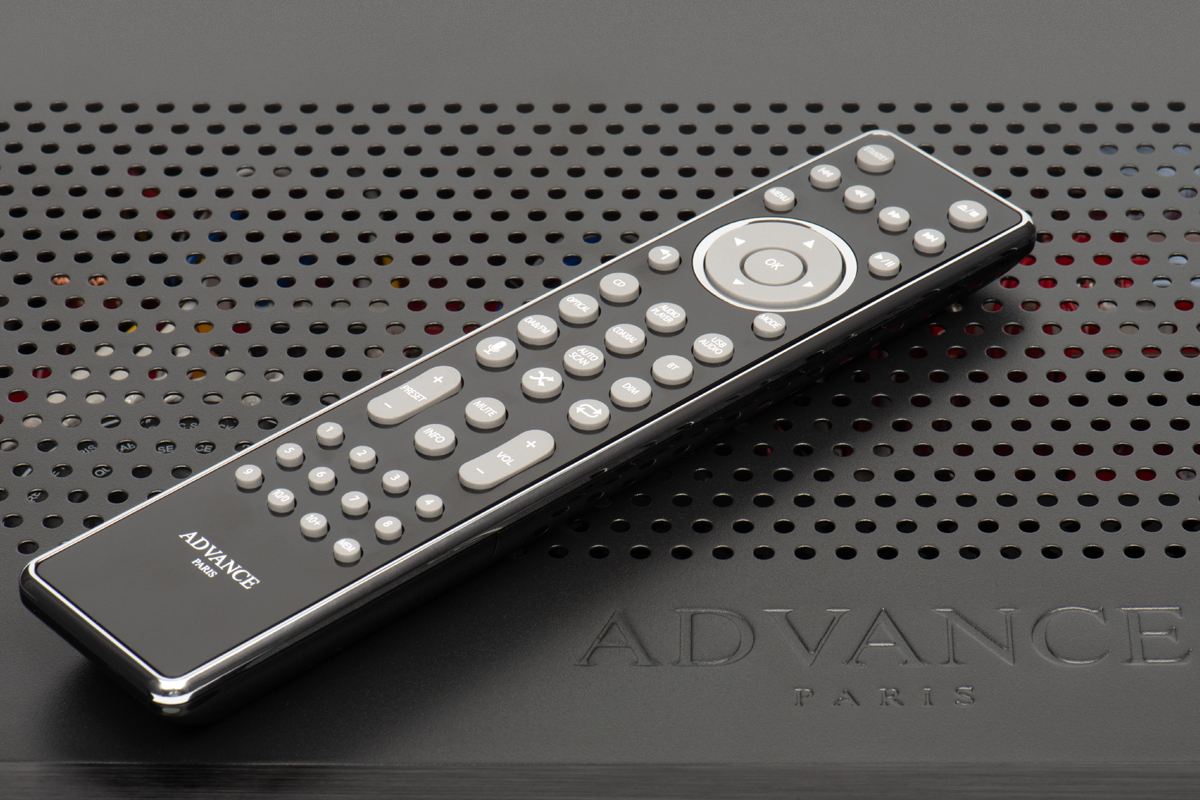
In terms of actual hardware configuration, most of that is done through the front-panel display along with the remote control. Through the app, you can rename your PlayStream A7, create some presets, set up an alarm, and a few other similar functions. You’ll need to interact with the amp itself directly to do things such as adjust tone controls; choose between A, B, or A+B speaker output; set up the Amp In; and so forth.
Far as I could tell, there is no bass management to fiddle with. Plugging in a subwoofer doesn’t engage any sort of crossover, nor can you manually configure one, unless I just missed something. That might be something worth considering if you’re running a 2.1- or 2.2-channel setup.
Listening impressions
My very first impression upon sitting down for some critical listening was that the PlayStream A7 seems engineered to drive full-range speakers like a drag-racing funny car. I don’t even need to see the measurements of this one to tell you with reasonable confidence that output impedance is low (hence, damping factor is high) because the A7’s amps manipulated the woofers of my reference Paradigm Studio 100 v.5 loudspeakers with equal parts nimbleness and righteous strength, like a 5th-Edition D&D player who somehow figured out how to effectively multiclass Rogue and Paladin.
I really heard this in one of the first reference tracks I threw at the amp: “Freedom! ’90” by George Michael (Listen Without Prejudice, Vol. 1, 24-bit/44.1kHz FLAC, Sony Music CG / Qobuz). If you read my reviews regularly, you might know that I use this one as a reference because it almost doesn’t have enough bass, which means that if the lower octaves diminish in any way, the mix becomes glaring and harsh, especially at higher listening levels. What struck me with the PlayStream A7 is that it sounded positively danceable at every listening level, with precisely the proper amount of bottom end no matter if the volume was set to: ‑30dB (resulting in a 74–77dB listening level from my seating position) or more like ‑15dB, which was as high as I could tolerate for any meaningful duration.
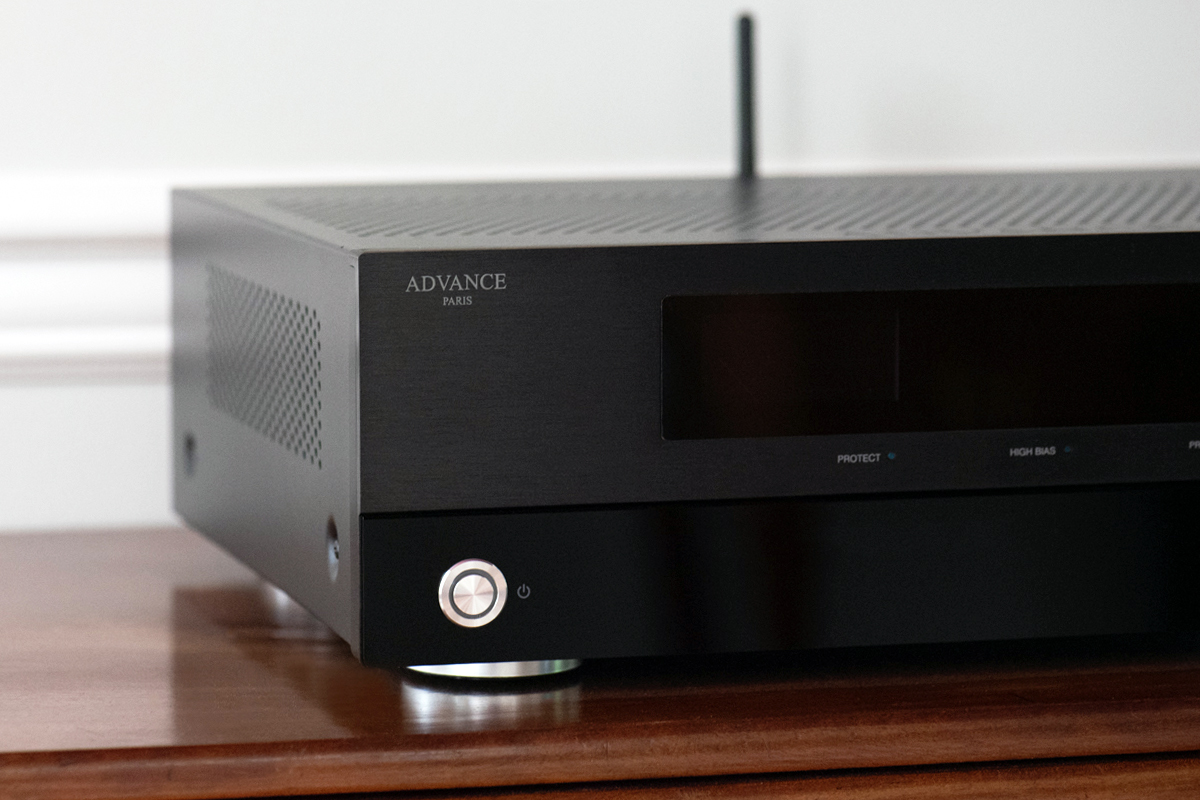
For something quite a bit less bass-shy, I turned my attentions to “Holy War” from the Dune (Original Motion Picture Soundtrack), which is credited to Hans Zimmer (24/48 FLAC, WaterTower Music / Qobuz). The thing about the bottom end in this one is that if you’re listening through smaller speakers, you might miss the depths of its bass for the first 49 seconds or so. Until that point, the mix works without the bottom end, so it’s one of those tests tracks that immediately stands out if everything is firing on all cylinders, because you hear deep rumbling you wouldn’t otherwise. That enhanced depth lets you know you’re in the presence of a full-bandwidth sound system that isn’t struggling or straining in any way.
Once the more prominent bass elements really kick in, though, I have to say that the PlayStream A7’s performance becomes all the more impressive. It’s quite easy for this cut to sound bloated and boomy if bass isn’t every bit as well-controlled as it is powerful. The Advance Paris piece handled all of that effortlessly, while also delivering the strings and horns and synths beautifully. The depth and width of the soundstage were positively palpable, and I found myself drawn in by the delicious image specificity, especially with the vocals.
Curiously, Advance Paris doesn’t give many details with regard to the implementation of the PlayStream A7’s DAC (which the website curiously lists as a TI PCM1796, whereas the manual says it’s an AKM AK4490—the latter of which I’m skeptical of, since the same specs list the amp’s output impedance as 10K ohms), so I turned to some CD-resolution music with which I’m intimately familiar to see if I could at least get a sense of what sort of reconstruction filter is employed.
From listening to “Bears” from Lyle Lovett’s brilliant Step Inside This House (16/44.1 FLAC, Curb Records / Qobuz), I’m guessing it’s a pretty sharp rolloff, as I didn’t hear any diminishment of the uppermost frequencies, nor much smoothing of transients. Overall, the PlayStream A7’s delivery of “Bears” was equal parts punchy, precise, effortless, uncolored, rich, nuanced, and super-detailed. 10/10, as the kids say these days.
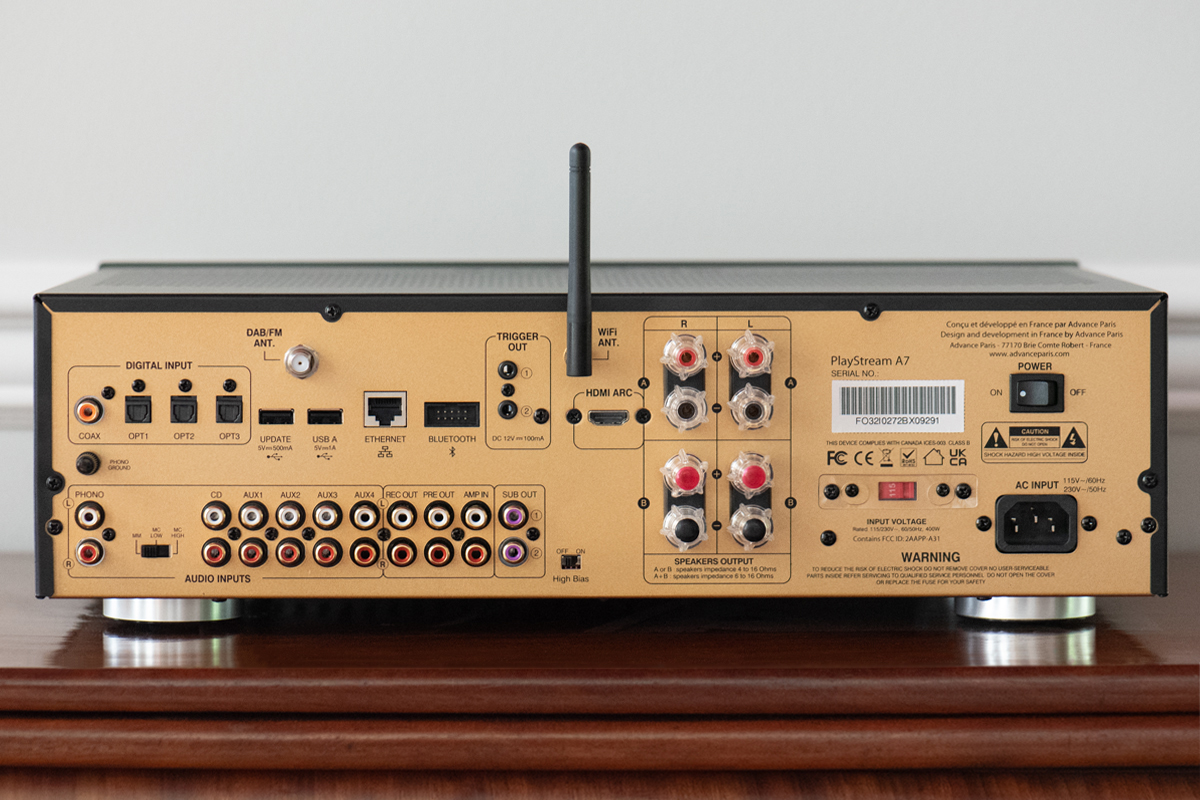
Switching over to the MM phono input, I cued up one of my go-to LPs, King Gizzard & the Lizard Wizard’s Omnium Gatherum (KGLW-013-2LP), and let rip the only song on side A: “The Dripping Tap.” My first impression was that the PlayStream A7’s phono stage doesn’t adhere to the RIAA curve as strictly as I’m accustomed to with my NAD C 3050 integrated amp and the optional phono pre built into my U-Turn Orbit Theory turntable. I say that because the overall mix of the track, which I listen to at least once a week, sounded ever-so-slightly smiley-faced to my ears. It benefited from equal measures of extra sparkle and a good bit more thunder from down under. If we had measured this piece and I’d seen those measurements, I’m guessing I would have decided ahead of time that I wouldn’t like this sort of coloration. Much to my surprise, I very much did.
But anytime I hear tonal colorations, I immediately start looking for problems. Once you deviate much from neutrality with regard to frequency response, one track might sound great while another might fall flat.
Try as I might, I just couldn’t find an LP in my meager collection that sounded bad, mostly because the deviations from neutrality—a bit of a bump in the deepest bass, some extra emphasis above maybe 3kHz or 4kHz—don’t seem to be of very high magnitude and don’t seem to be in the frequency range to which the human hearing system is most sensitive. So with something like Dodie’s cover of “Old Devil Moon” from Chet Baker Re:imagined (Decca Records 7544025), what I heard was a swinging cut that sounded a good bit more boppin’ and appreciably more spacious and open than I’m used to, but only to a degree that audiophiles would care about. I think most normies would miss the colorations entirely.
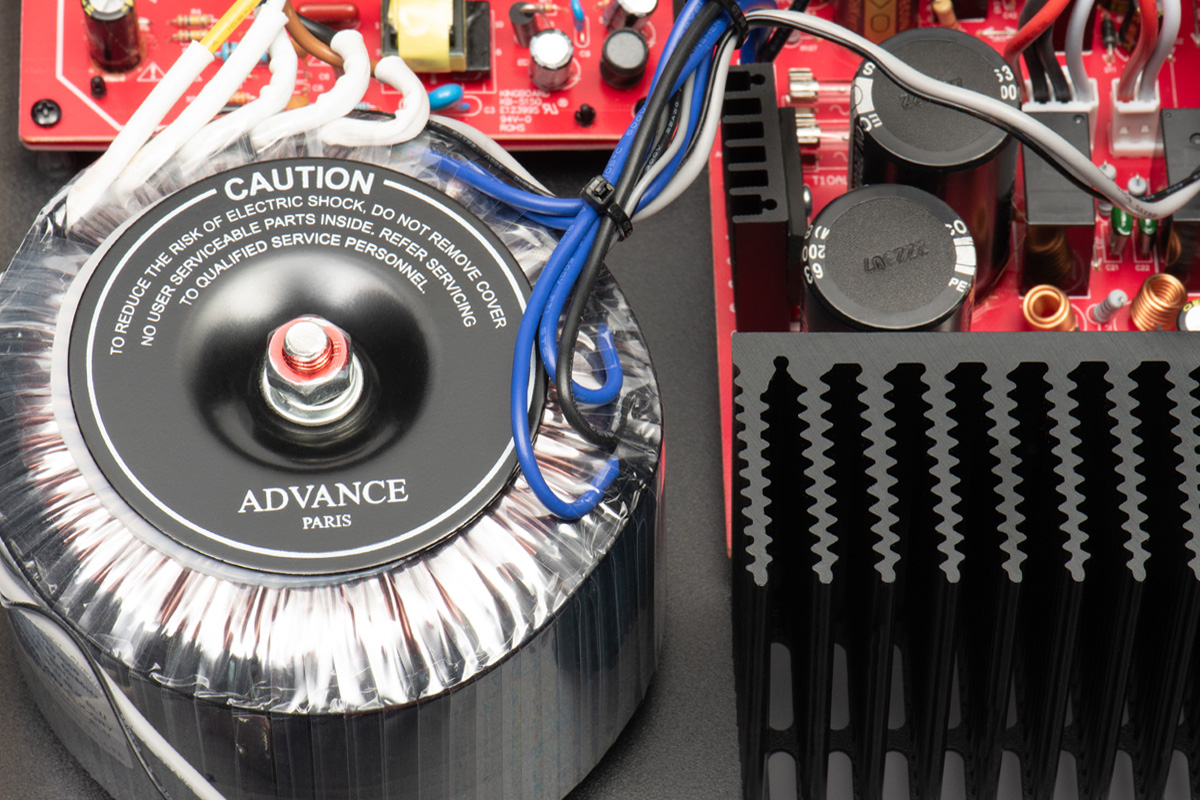
Oddly, it wasn’t until I looped all the way back around to the King Gizzard & the Lizard Wizard section of my vinyl shelf that I found a record whose sonic characteristics didn’t seem to benefit from this bit of juicing. Laminated Denim (KGLW-033LP) struck me as a little too dense, a little too cluttered, a little too much overall. But, like, what does that even mean? Even as I’m looking over my notes from that listening session, I’m not sure.
On the other hand, my warped pressing of Butterfly 3000 (technically 나비 3000, given that it’s the Korean variant) revealed that the PlayStream A7’s phono stage has an excellent rumble filter. Bonus points there.
After putting my records through their paces, I switched back to Qobuz for some proper evaluation of the PlayStream A7’s High Bias switch, which—just as a reminder—raises the standing bias current from some mysterious default up to the point where the amp operates in class A for the first watt. I relied mostly on “Oltre Terra” from Hania Rani’s Ghosts (24/48 FLAC, Gondwana Records / Qobuz) for this one, since it’s a brilliant mix of ambient pads and prepared piano, which results in an unmistakable texture with which I’m abundantly familiar.
There’s just one problem, though. If I pushed the amp to the point where its front-panel VU meters crossed the unmarked 1-watt mark, I couldn’t sit in the room with the thing. Still, flipping the switch back and forth, I didn’t notice anything that could be categorized as a meaningful difference. If you have a much larger room or much less-efficient speakers, you might be able to push the amp hard enough for this feature to matter.

I also checked out both headphone outputs and was unimpressed, whether using my Audeze LCD-2 open-back cans or my Ultimate Ears custom in-ear monitors. Tonality seemed off, distortion seemed a bit high to my ears, and although there was enough gain on both outputs, neither was a satisfying listening experience. What’s more, getting up close with the amp revealed that adjusting the volume with the lovely front-panel knob resulted in some quiet-but-audible crackling.
Comparisons
If what you’re looking for is a good blend of old-school hi-fi street cred and new-school streaming audio, I might point you in the direction of Rotel’s S14 streaming integrated amplifier, which sold for $2500 or thereabouts when I reviewed it back in 2023, making it the only thing I’ve seen in recent memory that actually costs less these days, selling for closer to $2000 at most retailers. It’s not quite as powerful and nowhere near as input-rich. It doesn’t even have a built-in phono stage. Nor is it multiroom capable. But it does have a proper screen up front (although, of course, no VU meters), and I never had any issues with the app failing to find the amp, as was occasionally my experience with the Advance Paris.
Conclusion
The Advance Paris PlayStream A7 is—make no mistake about it—a quirky beast. Ergonomically, it’s a bit idiosyncratic. You sort of need to rely on a combination of the remote and front-panel controls to operate it efficiently. Its app can be obstinate, although it usually behaves well and is a pleasure to navigate.
But for all that, I found the PlayStream A7 utterly charming. I was, in a word, smitten with it, for all its unpolished edges and curious design choices. It has a personality all its own, which is in short supply in our hobby these days. It’s hard for me to imagine a speaker this thing wouldn’t drive, within reason and assuming you’d spend a commensurate amount on your transducers and electronics. And it’s just a pleasure to look at. To me, that’s important.
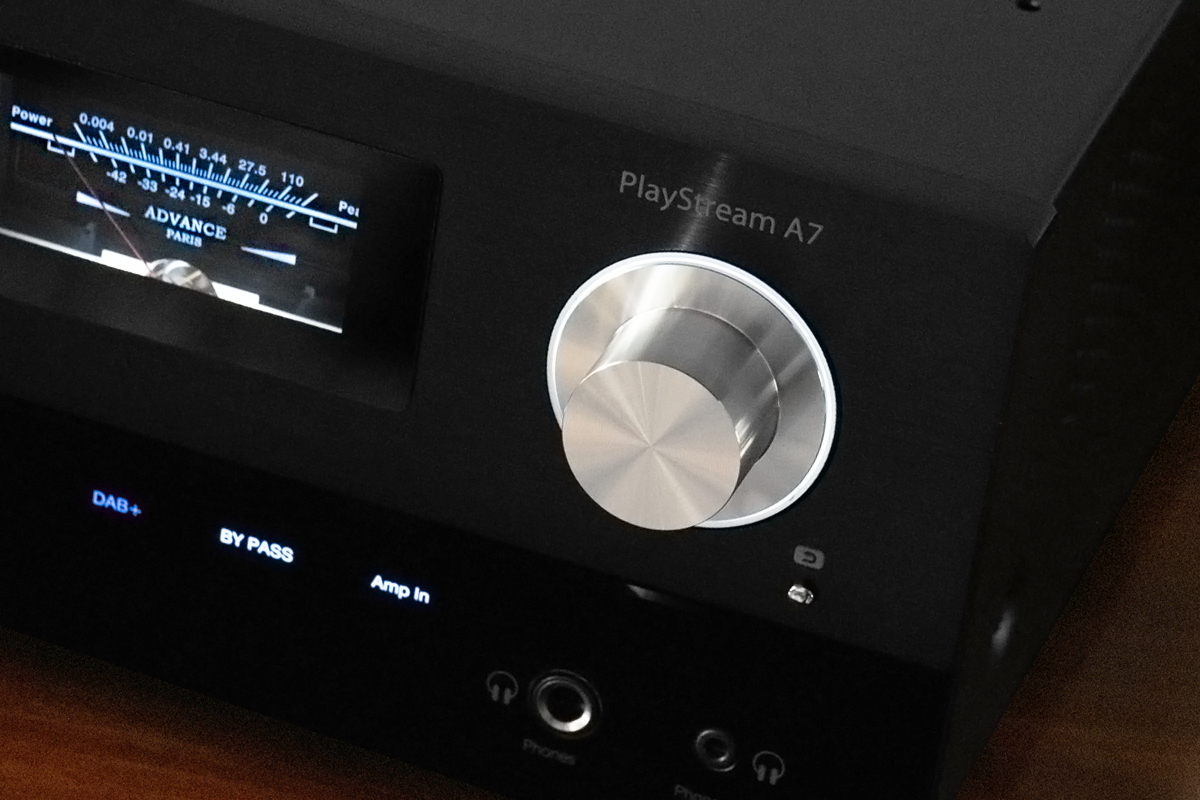
It probably won’t be the right streaming integrated amplifier for most Simplifi readers, but that’s OK. More than OK, actually. For the people who will vibe with what Advance Paris is doing here, I think its distinctive qualities—including its quirks—will give it the sort of charm that far too many connected components lack.
. . . Dennis Burger
Associated Equipment
- Speakers: Paradigm Studio 100 v.5
- Speaker-level connections: SVS SoundPath Ultra
- Sources: iPhone 16 Pro Max, U-Turn Orbit Theory
- Power protection: SurgeX XR115 Surge Eliminator/Power Conditioner
Advance Paris PlayStream A7 streaming integrated amplifier
Price: $2499, CA$2350, £1750, €1499
Warranty: Two years, parts and labor
Advance Paris Sarl
13 rue du coq gaulois
77390 Brie Comte Robert
France
Phone: +33 (0) 160 185 900
Website: advanceparis.com
US distributor:
Playback Distribution LLC
3257 Wildlife Trail
Zionsville, IN 46077
Phone: (317) 603-8114
Website: playbackdistribution.com





